Code 11.59 By Audemars Piguet Ultra-Complication Universelle RD#4
6 February 2023More than a century after the production of its ultra-complicated Universelle pocket watch, Audemars Piguet introduce its very first ultra-complicated selfwinding wristwatch (RD#4) in the design of the Code 11.59 by Audemars Piguet collection. While paying tribute to the Manufacture’s legacy of high complications, the Code 11.59 by Audemars Piguet Ultra-Complication Universelle RD#4 has been crafted with ergonomics and contemporary usage in mind to offer unprecedented comfort and simplicity of use. This new creation regroups the Manufacture’s horological savoir-faire into a single movement, the selfwinding Calibre 1000, which counts over 1,100 components. This pioneering mechanism builds on three generations of R&D innovations and incorporates 40 functions, including 23 complications, among which a Grande Sonnerie Supersonnerie, a minute repeater, a perpetual calendar, a split-seconds flyback chronograph and a flying tourbillon. Engineers, designers, watchmakers and craftspeople worked hand in hand for over 7 years to bring this RD#4 timepiece to life.
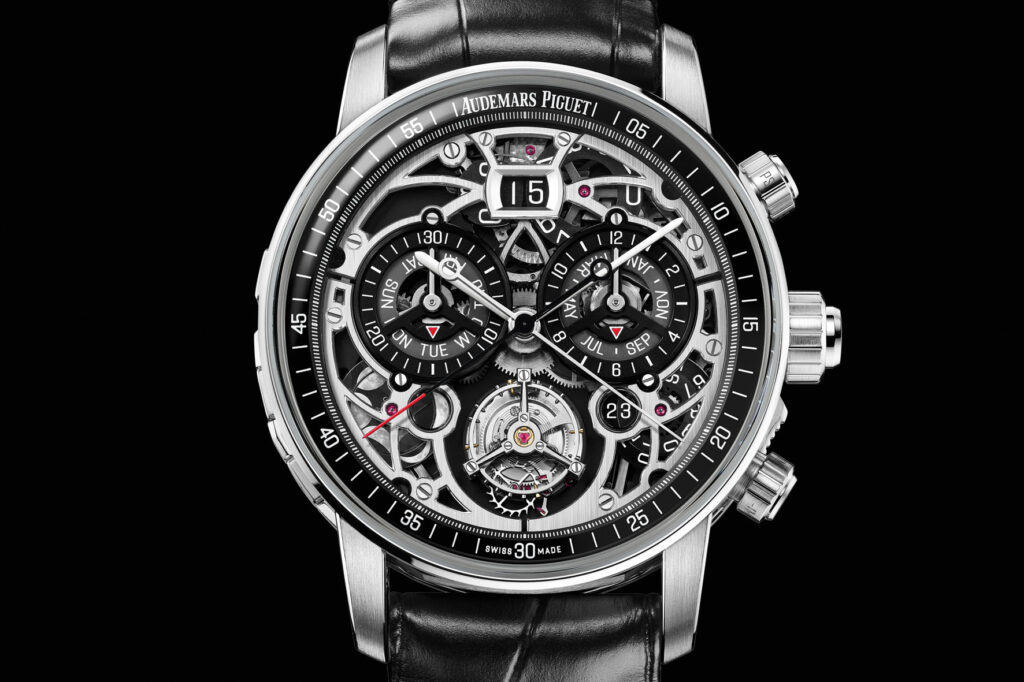
“This new Ultra-Complication is the culmination of several decades of research, design and manufacturing of many different types of complicated mechanisms that have put ergonomics at the forefront of the process. To achieve the highest level of reliability, while also keeping the thickness of our calibres to the minimum, we believe that a ‘mechanical function with an ergonomic focus’ opens a new path for Audemars Piguet and the watch industry as a whole.”
Giulio Papi Technical Director, Audemars Piguet Le Locle
GENESIS
The project debuted in 2016 with the goal of developing a highly complicated wristwatch fit for everyday use that would strike the right balance between complexity, ergonomics and aesthetics. Going beyond traditional norms of construction, the teams blurred the line between movement and case by developing ergonomic correctors and crown-pushers allowing users to activate the watch’s multiple functions with ease. They also incorporated and built on the Manufacture’s three recent R&D innovations – the Supersonnerie technology unveiled in 2015 (RD#1), the ultra-thin perpetual calendar movement launched in 2018 (RD#2) and the oscillator with increased amplitude premiered on the two Royal Oak Selfwinding Flying Tourbillon Extra-Thin RD#3 models released in 2022. In 2023, this project led to RD#4 and the creation of a remarkable wristwatch powered by an ultra-complicated selfwinding movement counting over 1,100 components. Calibre 1000 incorporates 40 functions, including 23 complications as well as 17 special technical devices, paving the way for a new generation of R&D movements.
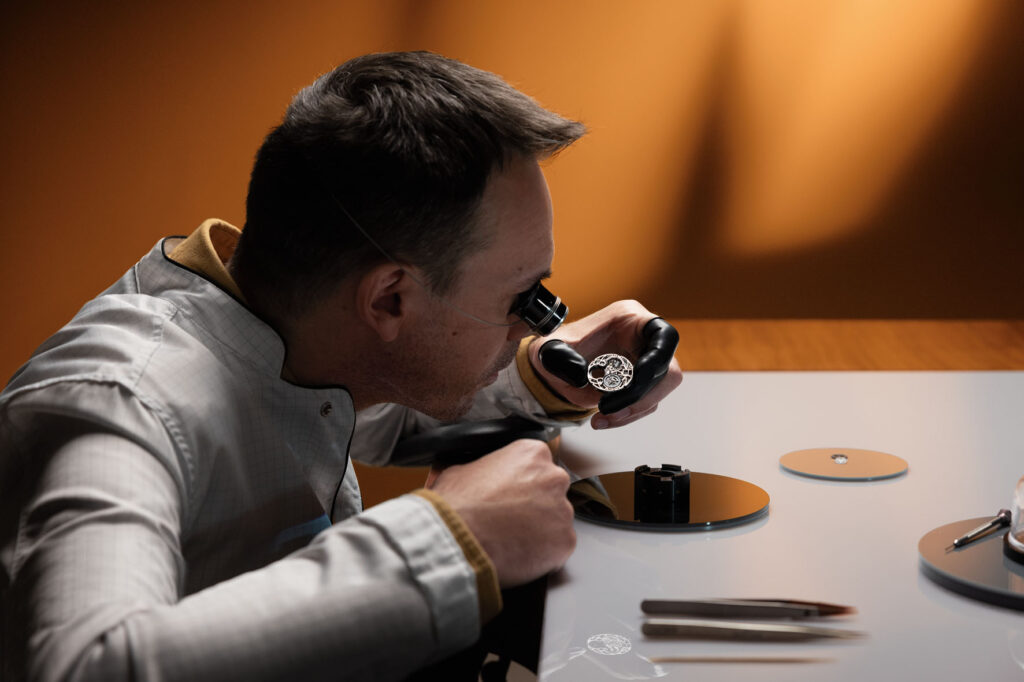
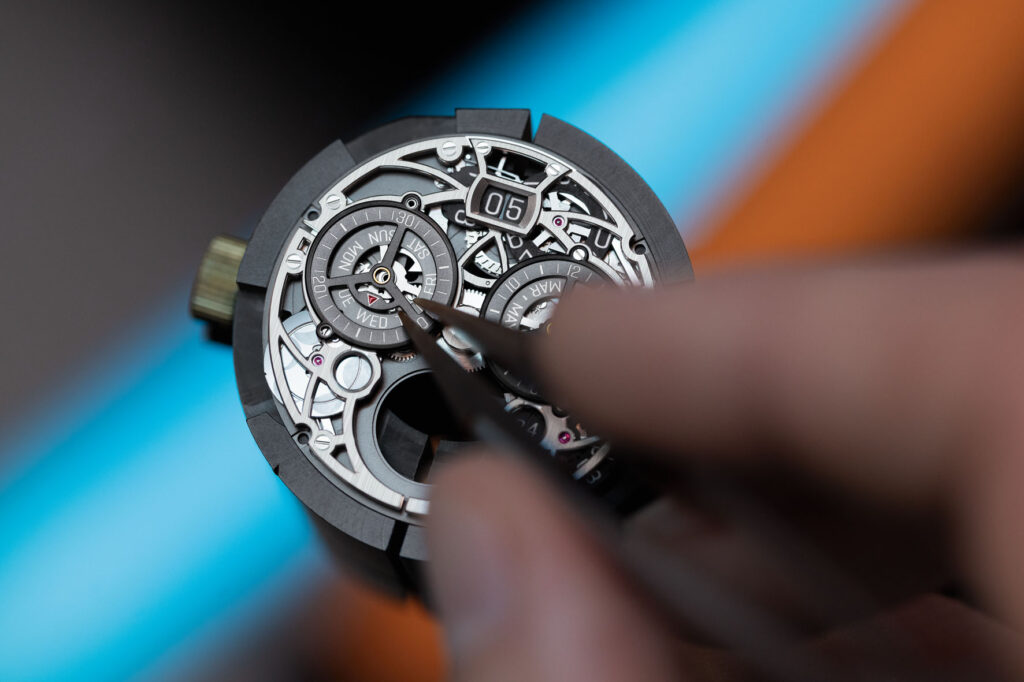
Seven years on, Calibre 1000 sees the light of day in the Code 11.59 by Audemars Piguet collection – itself an uncompromising bridge between past and future, classic and contemporary. While the case has retained both the ergonomic curvature and design codes of the collection, its proportions have been slightly adapted to fit this ultra-complicated mechanism. This new case measuring only 42 mm in diameter (instead of 41 mm) and 15.55 mm in thickness represents a real feat of engineering.
CROWNS AND PUSHERS
The Manufacture’s uncompromising approach to craftsmanship and engineering guided the development of this ultra-complicated timepiece. The teams combined some of the most prestigious horological complications in one single selfwinding movement measuring no more than 34.3 mm in diameter (15 lignes) and 8.75 mm in thickness, while enhancing users’ comfort and experience. One of the major technical developments consisted in simplifying the use of the functions for the wearer by reducing the high number of pushers and correctors usually found on highly complicated timepieces to three crowns and three push-pieces.
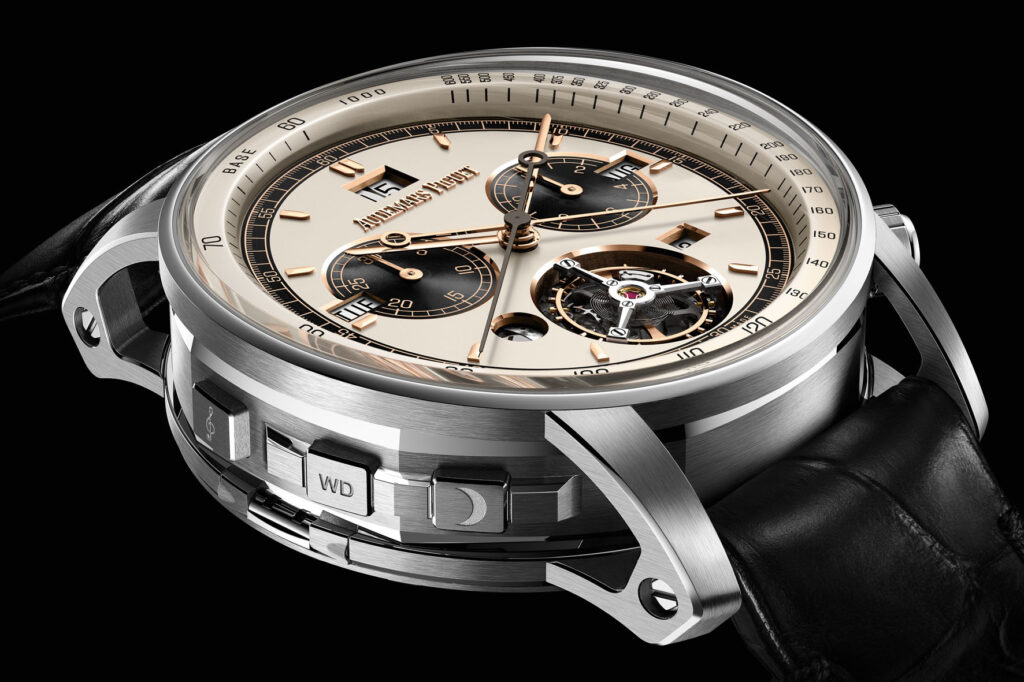
The pushers have been integrated to the case’s left side. While the top one starts the minute repeater function, the two pushers respectively serve to correct the moon and day indications – a system entirely rethought to facilitate correction without resorting to minuscule, sharp tools.
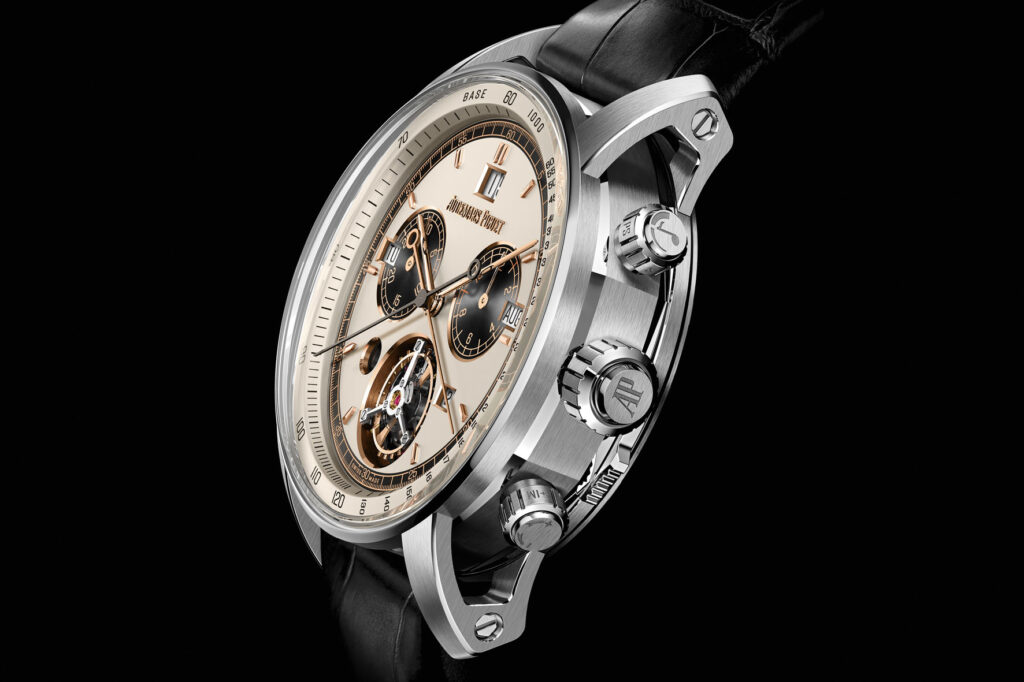
On the right side of the case, three crowns with coaxial pushers allow the wearer to wind the watch, set the time and date with the central crown and select the chiming mode (Grande Sonnerie, Petite Sonnerie or silence mode). The flyback chronograph can be started and stopped with the supercrown at 2 o’clock and reset with the other supercrown at 4 o’clock. The 4 o’clock crown also corrects the month in sync with the year. Among the innovations, the ergonomic crown-pusher – or “supercrown” – at 4 o’clock brings correction to a new level. While the pusher actuates the flyback chronograph’s zero resetting mechanism, the crown also enables the forward or backward correction of the month. In addition, the crown automatically returns to its neutral position after rotating it (up to 70°) in either direction. This ease of use hides highly technical mechanical devices located in both the crown and the movement, as well as a complex security system preventing misuse.
Lastly, small intuitive symbols engraved on each crown and push-piece remind the wearer of their respective functions.
CHIMING TIME
The Code 11.59 by Audemars Piguet Ultra-Complication Universelle RD#4 represents the latest in terms of chiming mechanism as it combines the sophisticated Grande Sonnerie with the patented Supersonnerie technology introduced by Audemars Piguet in 2015.
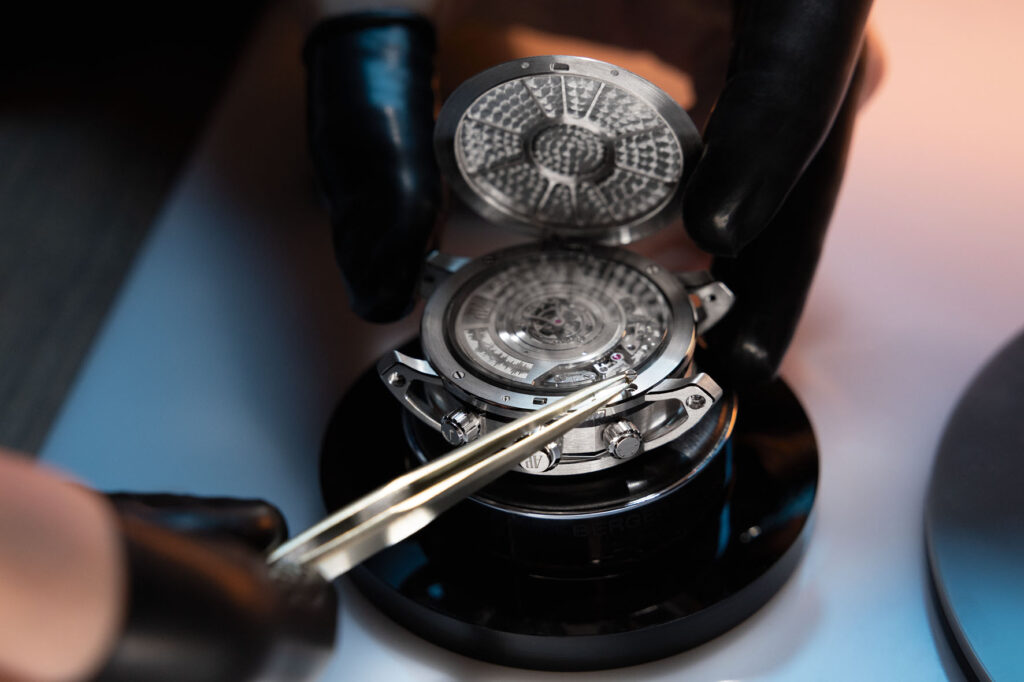
A Grande Sonnerie timepiece strikes the hours and every quarter hour by passing (repeating the hour before the quarter every time), without any involvement from the wearer. In the Petite Sonnerie position, the watch chimes the hours only, while the automatic chiming is deactivated in the silent mode. Additionally, the wearer can activate the minute repeater mechanism at any time via the dedicated push-piece located at 10 o’clock. To optimise energy management and distribution, the timepiece’s chiming functions are fed by a dedicated barrel that is wound by the movement of the wrist, alternately with the main barrel.
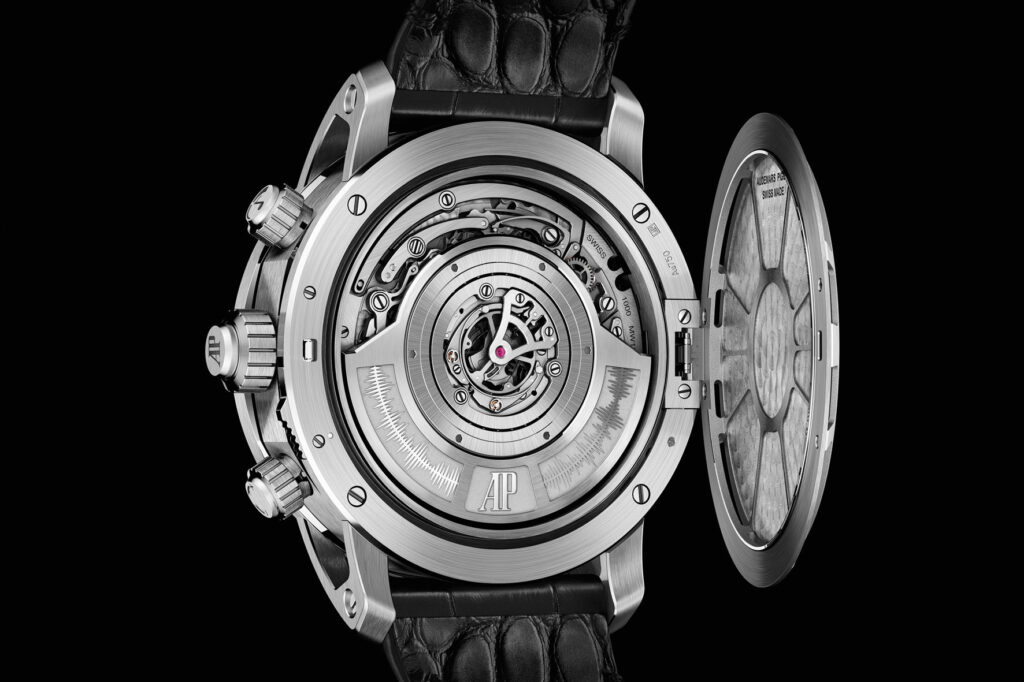
Pushing the limits of feasibility one step further, the Manufacture’s engineers and watchmakers revised the Supersonnerie construction for the Code 11.59 by Audemars Piguet Ultra-Complication Universelle RD#4 to reveal the beauty of the mechanism, usually hidden on the caseback side by the technology’s resonance chamber. To bring the ultra-complicated Calibre 1000 to light, they developed a dedicated double caseback system comprising a “secret” extra-thin cover and a new soundboard, just 0.6 mm thick, entirely crafted in sapphire crystal, on which the gongs are mounted. Three years of development were necessary to create a water-resistant sapphire component with the right geometry and thickness capable of acting as a soundboard.
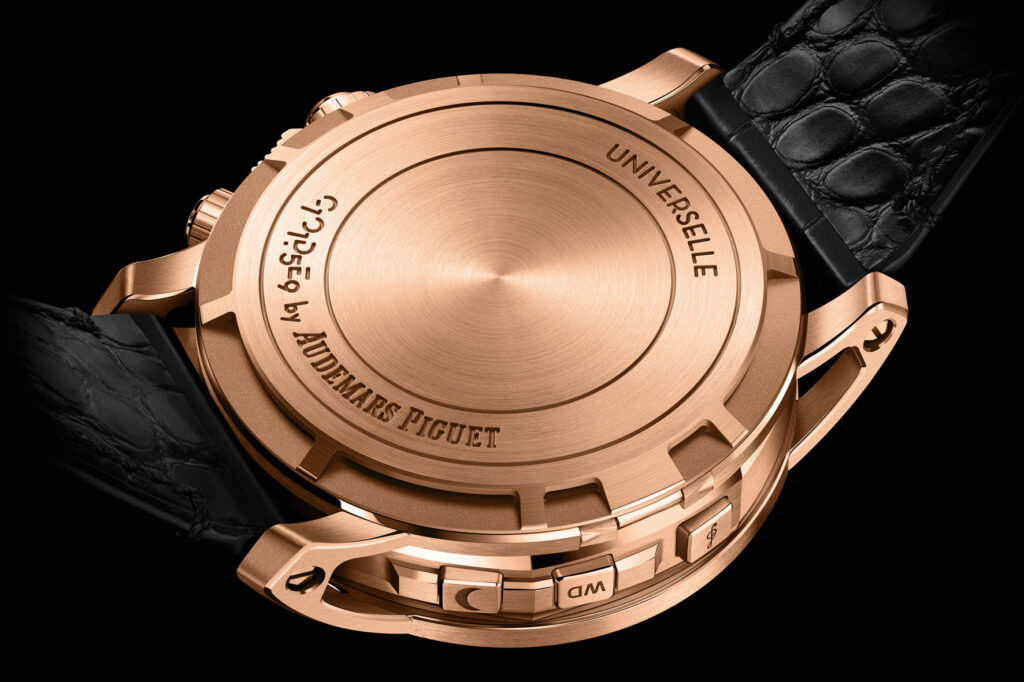
The “secret” cover features a series of apertures on the side to let air through and boost sound amplification when the watch sits on the wrist. Furthermore, it has been hollowed out to retain as little material as possible to reduce the case’s general thickness. This pivoting cover can be opened thanks to a discreet lever located just under the crown at 3 o’clock on the back side to admire the split seconds mechanism and the dedicated platinum oscillating weight. Lastly, the oscillating weight boasts an array of refined finishing techniques, including engraved sound waves that nod to the timepiece’s remarkable acoustic performance.
THE PERPETUAL CALENDAR
The semi-Gregorian perpetual calendar mechanism has been conceived to optimise the display and use of the calendar functions, while taking as little space as possible. To do so, Calibre 1000 builds on the patented innovations of Calibre 5133 premiered in 2018 with the release of the Royal Oak Selfwinding Perpetual Calendar Ultra-Thin RD#2 prototype, which merged the perpetual calendar functions onto one single level. The end-of-the-month cam has been similarly integrated to the date wheel, while the month cam has been combined to the month wheel. To enhance the watch’s ergonomics, additional calendar functions, such as the large date at 12 o’clock and the year indication at 4 o’clock, complement the perpetual calendar mechanism.
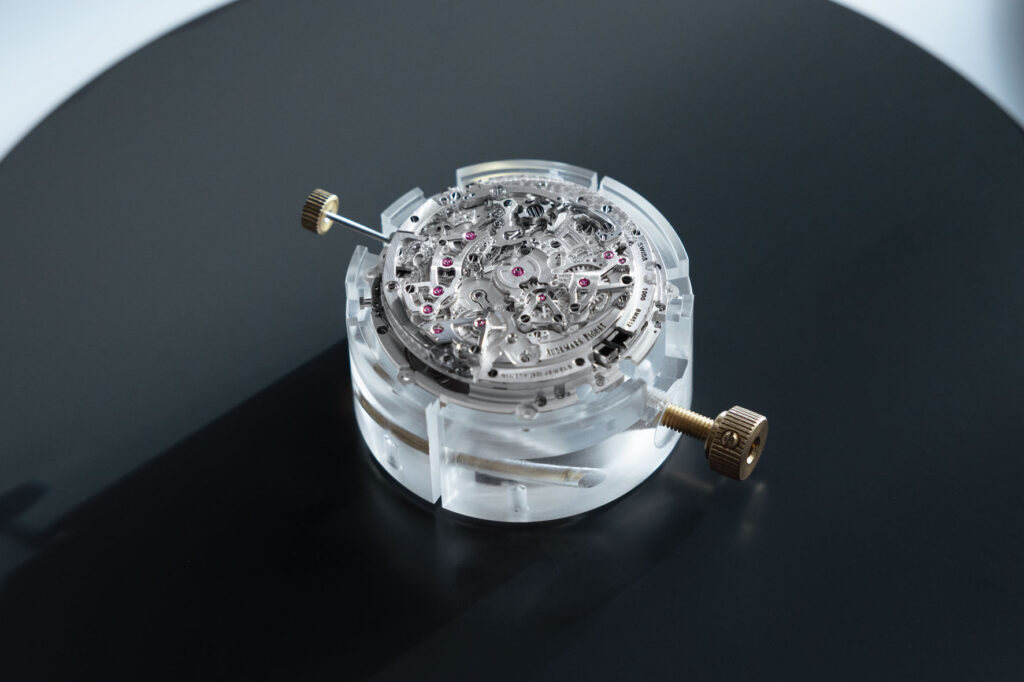
Furthermore, the correction system of the calendar functions has been simplified for the user. While the day and moon phases can be corrected thanks to two dedicated pushers located on the left side of the case, the reversible date system enables to move the date forwards and backwards by turning the crown at 3 o’clock in either direction. The month, too, can be adjusted forwards or backwards via the innovative “supercrown” at 4 o’clock.
Similarly, the display of the perpetual calendar functions combines optimum legibility with refined aesthetics. Calendar indications have been dissociated from the chronograph counters and organised symmetrically on the vertical axis. In addition to displaying the day, large date and month at 9, 12 and 3 o’clock respectively, the timepiece indicates the year thanks to a two-digit window located at 4 o’clock – a system which replaces the more traditional leap year indication. Synchronised with the month, the year changes automatically every time the month wheel moves from December to January. The semi-Gregorian perpetual calendar mechanism thus advances the day, date and year automatically taking into account the number of days per months, leap years included, as well as the 100-year correction normally required in traditional Gregorian perpetual calendars. No manual adjustment is therefore required before the year 2400!
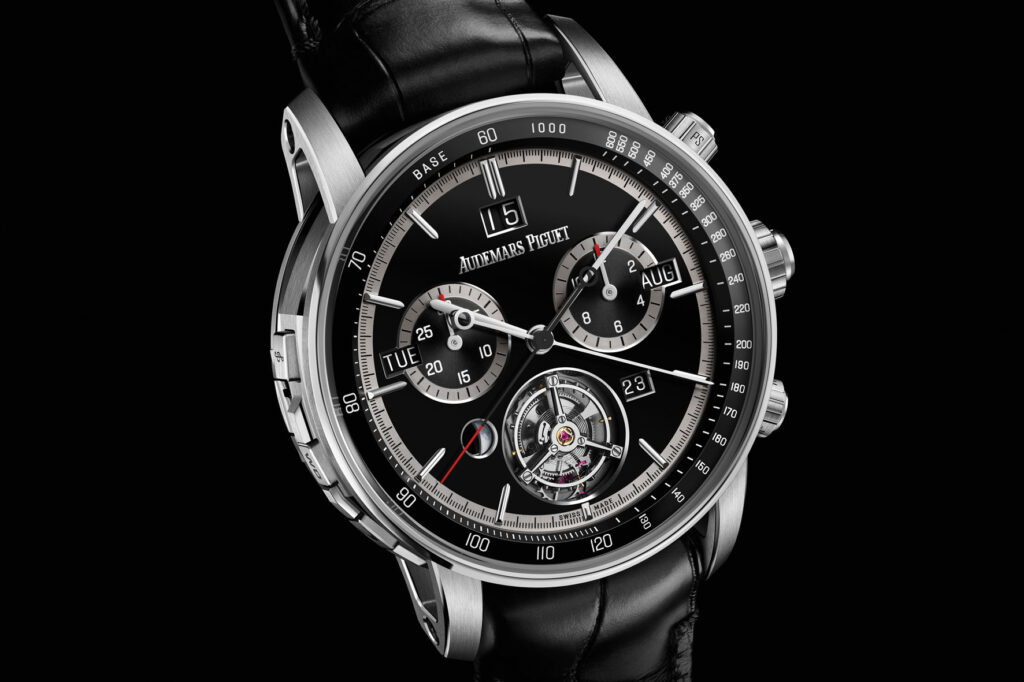
Lastly, the Code 11.59 by Audemars Piguet Ultra-Complication Universelle RD#4 incorporates an innovative instant-jump astronomical moon system that conveys a more realistic depiction of the moon. Two concentric discs, on which six different moon positions are printed, combine to form ten images faithfully representing the transitory waxing and waning stages between the New and Full Moon, as the satellite orbits around the Earth in an average of 29.53 days. As for other astronomical moons, this new moon image requires manual correction every 122 years, providing the watch has been kept fully wound.
THE SPLIT-SECONDS FLYBACK CHRONOGRAPH
Audemars Piguet devised a contemporary split-seconds flyback chronograph interweaving simplicity of use with visual appeal.
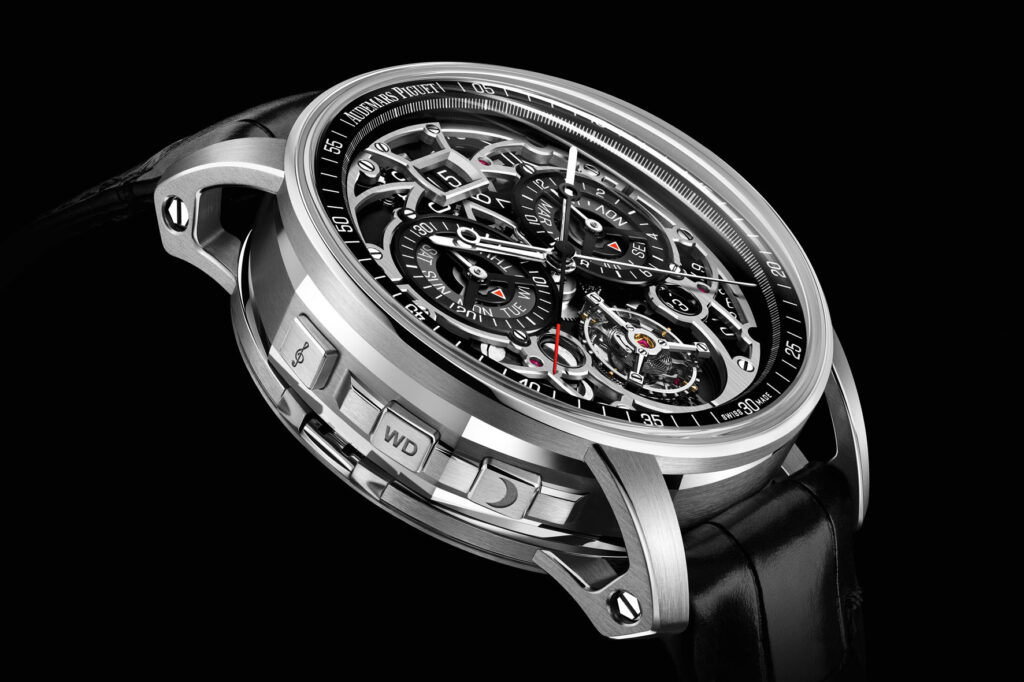
While the flyback chronograph allows to reset and restart the chronograph without having to stop it first, the split-seconds mechanism measures intermediate time intervals thanks to the addition of a split-seconds hand that can be stopped independently of the centre chronograph hand when the dedicated pusher is activated. When the push-piece is pressed again, it catches up to the running hand to continue their journey together around the dial, in perfect synchrony. The action can be repeated at will.
The flyback chronograph and split-seconds hand can be activated via the three crowns’ co-axial pushers on the case’s right side. The pusher at 2 o’clock starts and stops the chronograph, while the one at 3 o’clock actuates the split-seconds mechanism. Lastly, the pusher at 4 o’clock activates the flyback and zero resetting mechanisms.
Furthermore, the Code 11.59 by Audemars Piguet Ultra-Complication Universelle RD#4 is equipped with a dedicated swivel clutch that prevents the chronograph centre hands from stuttering when the mechanism is started. This type of clutch was launched in 2015 on the Royal Oak Concept Laptimer.
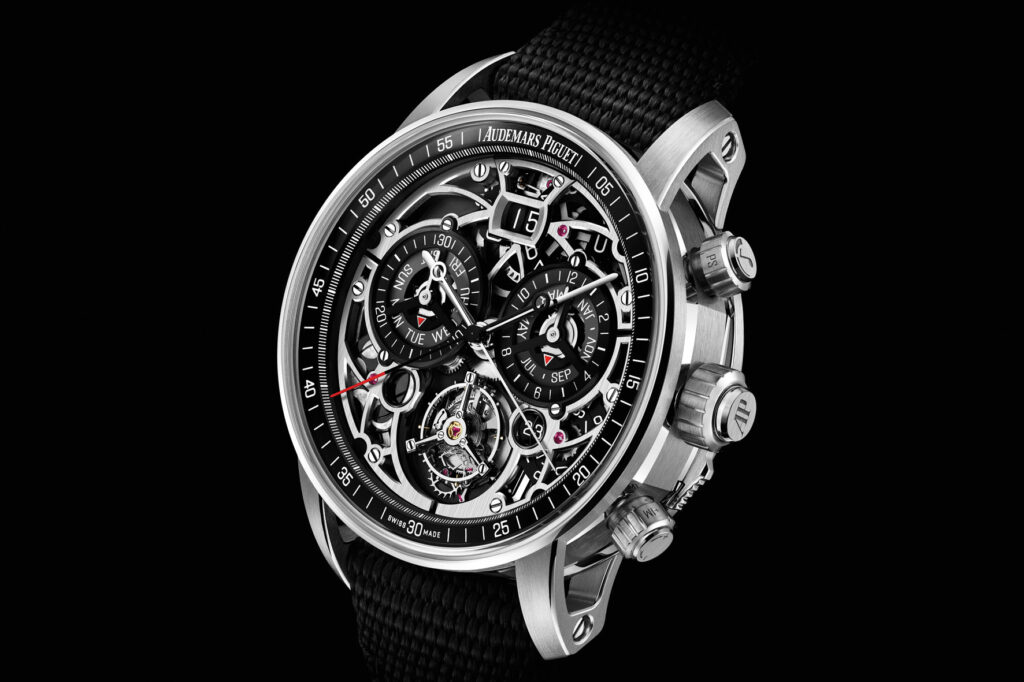
The architecture of the chronograph mechanism was further remodelled to save space and showcase components usually hidden from view on the caseback side. One of the major developments entailed integrating the split-seconds mechanism within the thickness of the central rotor’s ball bearing. By merging two systems usually superposed, Audemars Piguet engineers reduced the movement’s thickness by 1.1 mm, while revealing the beauty of the split-seconds mechanism when the user opens the watch’s “secret” cover.
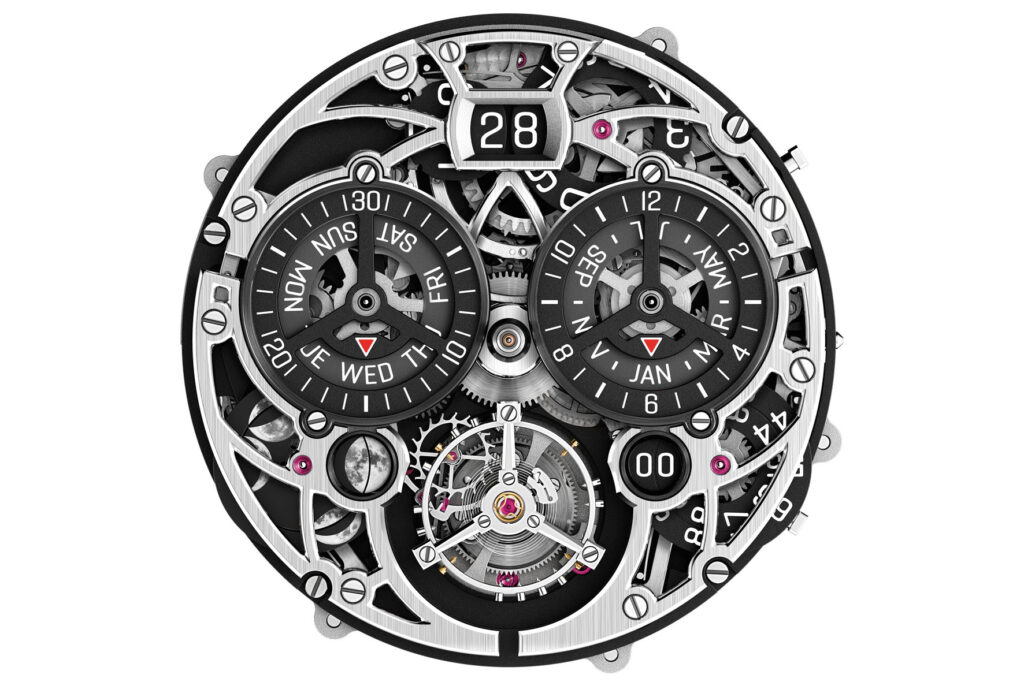
Lastly, to enhance the readability of the chronograph functions, the hour and minute counters have been enlarged and slightly decentred from the 3 – 9 o’clock axis to sit further away from the flying tourbillon cage at 6 o’clock.
THE FLYING TOURBILLON
The Code 11.59 by Audemars Piguet Ultra-Complication Universelle RD#4 is endowed with a flying tourbillon at 6 o’clock that completes a revolution every minute to correct the effect of gravity on the watch’s accuracy. This pulsating cage reveals part of the ultra-complicated timepiece’s beating heart, including its large amplitude oscillator.
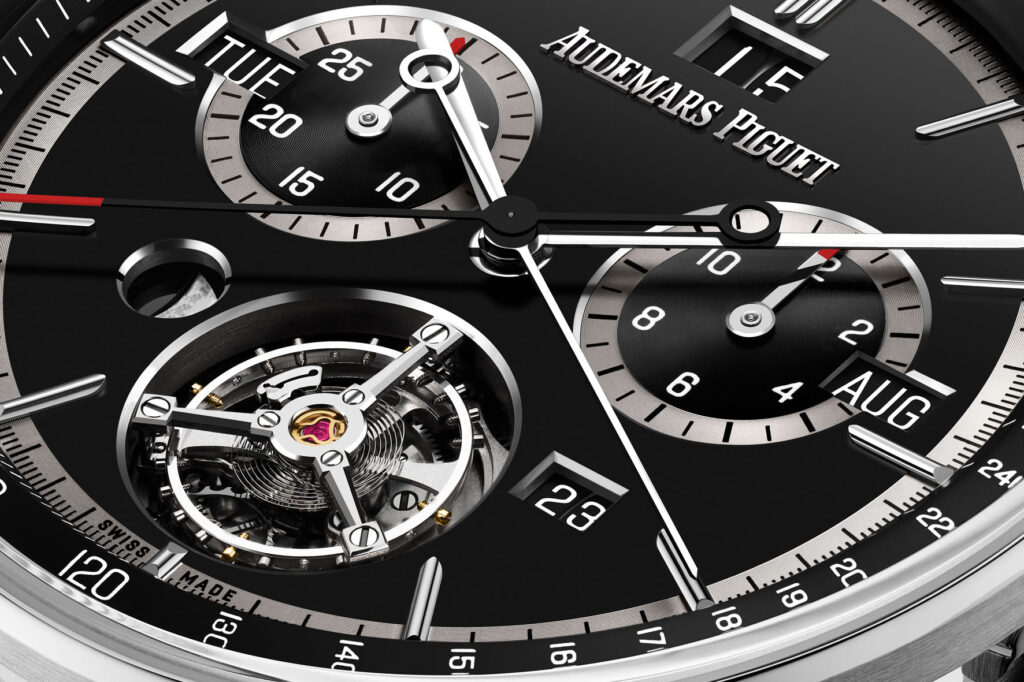
Indeed, to optimise energy distribution and efficiency, Calibre 1000 encompasses a new oscillator with increased amplitude, which the Manufacture premiered in 2022 on the two RD#3 Royal Oak Selfwinding Flying Tourbillon Extra-Thin models. To prevent the watch from stopping when all functions are working, the geometry of the escapement has been rethought to increase the amplitude of the balance and eliminate knocking – a state which occurs when excessive energy from the escapement is transferred to the oscillator. This solution also necessitated to increase the energy of the wristwatch’s base movement, while keeping a 21,600 vph frequency to highlight the beauty of the flying tourbillon on the dial side. A larger main barrel was thus developed to power the hands, as well as the chronograph and calendar functions, while the chiming complications are fed by a dedicated barrel. This more powerful mechanism grants the watch some 60 hours of autonomy when not on the wrist, depending if the functions are activated.
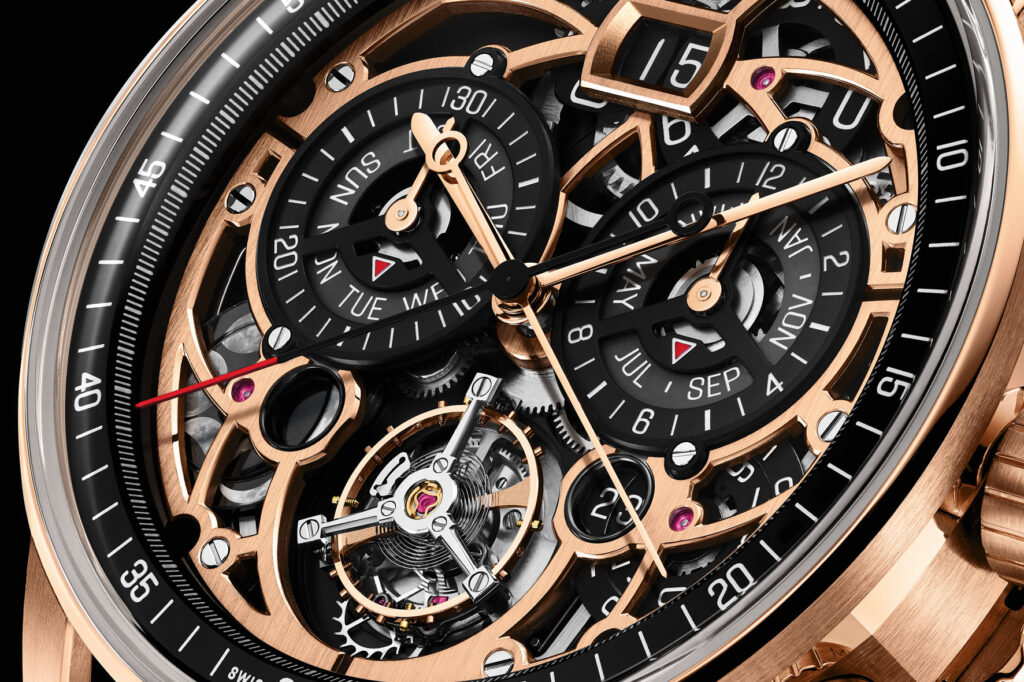
FOUR VARIATIONS
Four variations of the model crafted in 18-carat white or pink gold will be introduced in 2023, each endowed with a different dial marrying clarity with refined contrasts.
The first timepiece combines an 18-carat white gold case with an opaline black galvanic gold dial, inner bezel and chronograph counters illuminated by bright accents. The flying tourbillon cage at 6 o’clock, which reveals the rhodium-toned regulating organ pulsating within, echoes the chronograph counters’ light grey external zones as well as the zone around the dial, on which the black minute track and Swiss Made indication have been transferred. The white gold applied hour-markers and hands as well as the applied Audemars Piguet signature obtained by galvanic growth amplify the play of light.
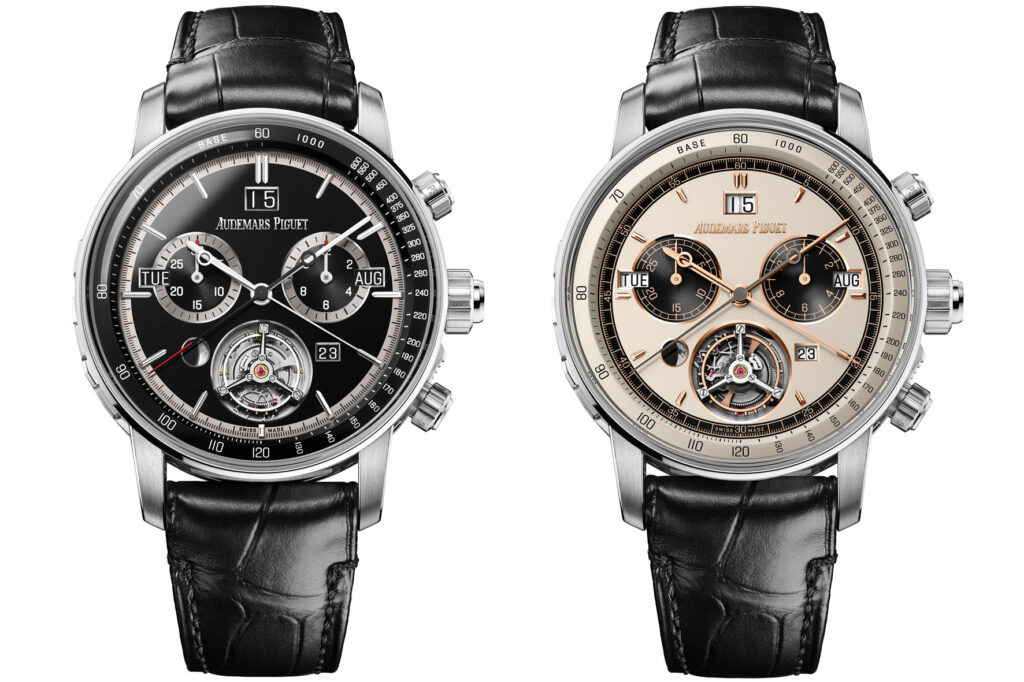
The second reference unites an 18-carat white gold case with an opaline beige PVD gold dial embellished by black chronograph counters and a black external zone on which the pink minute track and Swiss Made indication have been transferred. Discreet 18-carat pink gold hour-markers and hands, echoed by the pink-gold-toned balance wheel visible through the flying tourbillon cage, add the finishing touches.
The dial of the two references has been organised to maximise legibility of the chronograph and calendar functions by providing calendar indications in separate windows evenly spread across the dial. The day and month windows, located just above the hour-markers at 9 and 3 o’clock respectively, have been superposed to the circular minute and hour counters of the chronograph. This combination of shapes furthers the meticulous hand finishing adorning these ultra-complicated timepieces. Even the delicate gold threads encircling all counters and windows have been hand- finished with a very thin polished chamfer. Lastly, the dial’s juxtaposition of circular and angular geometries subtly recalls the architecture of the Code 11.59 by Audemars Piguet case.

The Manufacture also launches two references affording a glimpse of the refined components of Calibre 1000 on the dial side. The two timepieces incorporate an 18-carat white or pink gold case and a two-tone architectural dial featuring matching gold openworked bridges contrasted with black accents. To emphasise the dial’s multifaceted geometries, the day and month are now indicated on a grey zone at the centre of the partially openworked black chronograph counters. The collection’s double curved sapphire crystal furthers the play of light created by the dial and movement’s two-tone aesthetics.
The four 2023 timepieces are all fitted on a black alligator strap and come with an additional black textured rubber-coated calfskin strap for a touch of sporty elegance. (Price CHF 1,600,000 + Tax)


